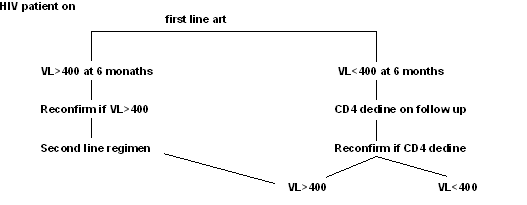AIDS SOCIETY OF INDIA
HOW TO IDENTIFY AND MANAGE ART FAILURE?
Identifying failure
-
Development of drug resistant to ARV
drugs is a common cause of ART failure. drug resistant is the ability of the virus to replicate in the presence of ARV Drugs. Additionally, inadequate adherence to the prescribed regimen can lead to treatment failure. Hence assessment of treatment adherence when a patient is identified with treatment failure is crucial and a repeat determination (PVL or CD4) after 4-8 weeks of intensive adherence counseling should be done before altering therapy. Finally insufficient therapeutic blood levels due to poor absorption, Drug-drug interactions or sub-optimal dosing can also lead to drug resistant and treatmentfailure. Acquisition of primary drug resistant virus or exposure to sub-optimal therapy (e.g. use of single dose NVP for MTCT) can also lead to treatment failure.
-
Antiretroviral failure can be defined in 3 ways: virological, immunological or clinical, in most instances one following the other. There is a delay between virological and immunological failure risking exposure of
HIV to a failing regime leading to development of further cross resistance and compromising the efficacy of the second-line regimen.104 Hence, if patients can afford, PVL determinations are recommended every 6 months to identify virological failure early.
The following definitions of ART failure are used:
Virological failure
Incomplete suppression of the virus on ART. It is defined as PVL value of >400 copies/ml at 6 months after ART initiation. Additionally, viral rebound after being undetectable is also considered as virological failure. Low-level viral rebound (<500-1000 copies/ml), termed blips, usually indicates statistical variation in PVL determinations and is not an indication to alter therapy.106
Immunological failure
A drop of greater than 30% in CD4 counts from peak value or a return to pre-ART baseline or lower is defined as immunological failure. Some patients may have a disconnect
phenomena where the PVL is undetectable and the CD4 may only have limited increase or there may be a fall in CD4 counts. Limited CD4 count reconstitution with optimal virological suppression can occur when the CD4 count is very low before initiating ART, in HCV co-infected patients, in elderly patients and rarely if a patient is on a ZDV based regimen.107-109 A drop of CD4 count in the presence of virological suppression can occur with underlying malignancies (e.g. NHL), super infection with
HIV-2.
Clinical failure
Progression of disease with occurrence of OIs or malignancies occurring after 3 months or more of ART initiation is defined as clinical failure. Within 3 months, differentiating between IRIS and OIs occurring because of inadequate CD4 improvement is difficult.
Managing failure
- summarizes an approach to identifying failure on first-line ART.
Identifying the cause of failure is important before deciding to modify the ART regimen. Following points need to be assessed:
-
Adherence: A detailed assessment of adherence needs to be done. The reasons for non-adherence need to be explored. Unless these reasons are identified, a patient may also find it difficult to adhere to the second-line regimen.
-
Drug-
drug interactions: Assessing whether the patient is concomitantly taking
medications which interfere with ARV activity is important. Many patients may not reveal that they take herbal treatments along with the prescribed ART regimen.
-
Continuing high risk behavior : If a patient continues to practice high risk behavior, super infection with a
drug resistant virus may lead to treatment failure.

Managing second-line failure
This is a complex issue and should be done in consultation with an expert. The goal of treatment of a third-line regimen depends on the availability of remaining options. Usually the goal of such treatment is to keep the CD4 counts up and PVL as low as possible, since achieving undetectable levels may be unrealistic. But with use of second generation PIs and entry inhibitors it is possible to achieve undetectable PVL levels insignificant number of patients. However, these
drugs are not available in India and are extremely expensive.